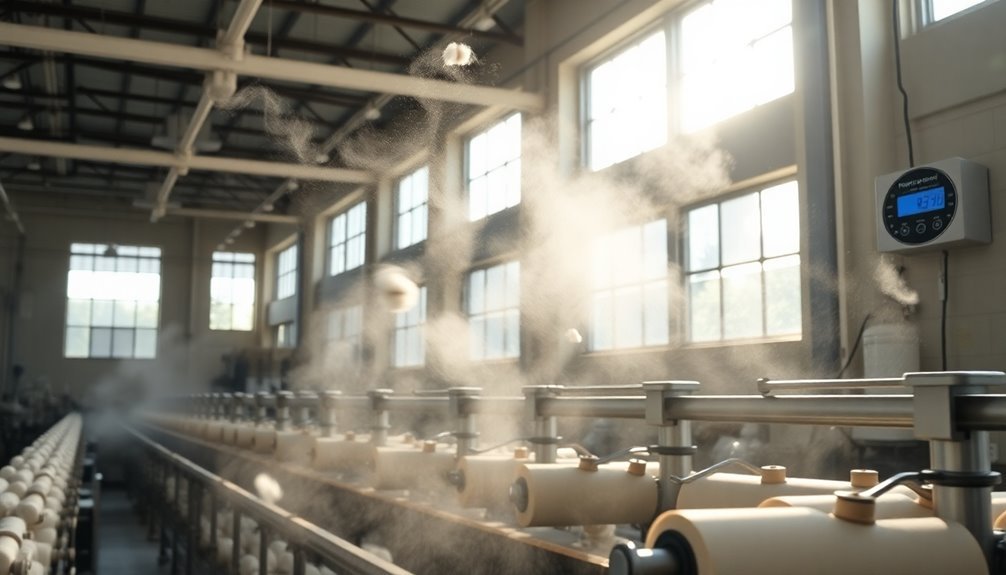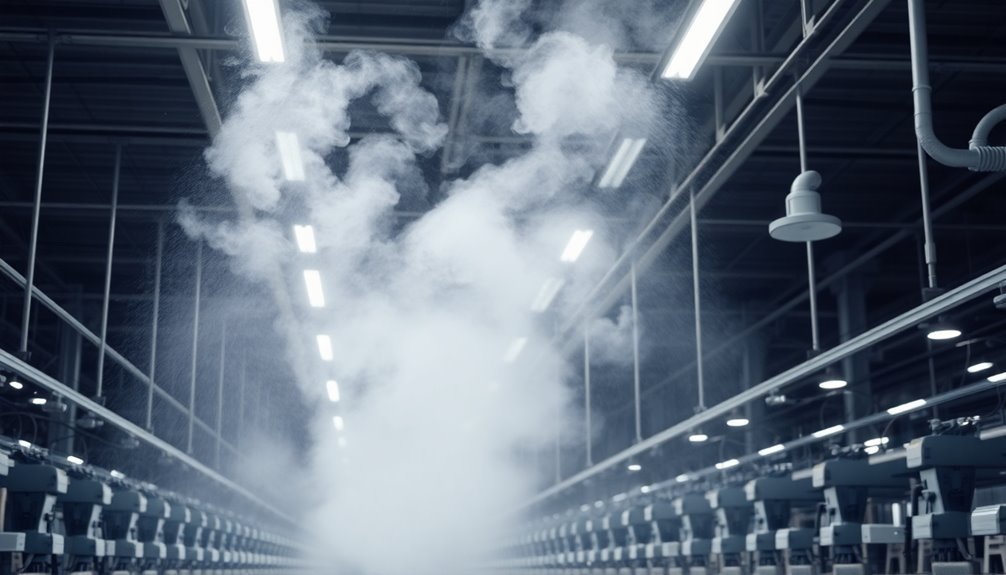Proper humidity control in your facility prevents static electricity through five key mechanisms. You'll prevent electron exchange between materials by maintaining humidity levels above 55% RH, which creates a natural conductive path for charges to dissipate. Your air moisture helps form a protective layer on material surfaces, reducing friction-based static buildup. Water molecules in the air actively neutralize existing static charges, while proper humidity maintains consistent conductivity throughout your workspace. You'll also benefit from decreased dust accumulation, which can carry static charges. Discover how these mechanisms work together to create a safer, more productive industrial environment.
Understanding Static Electricity Formation

Static electricity builds up when different materials rub against each other, causing electrons to transfer between surfaces. This process, known as the triboelectric effect, creates an imbalance of electrical charges, where one material becomes more negatively charged while the other becomes more positively charged.
You'll find this happening frequently in industrial settings where materials constantly interact through friction.
In your industrial facility, you'll encounter static electricity generation in various operations. When you're running conveyor systems, moving powders through pipes, or operating blending equipment, you're creating conditions for static buildup.
The movement and separation of materials during these processes lead to charge differences that want to equalize, potentially resulting in sparks. Sparks from static discharge can present serious fire and explosion hazards in industrial environments.
You need to be particularly vigilant in environments where you're working with power belts, pulverized materials in chutes, or fluid flow systems. These operations are common sources of static electricity, especially in industries like packaging, printing, plastics, and textiles.
Even your industrial machinery can create localized dry spots that encourage static formation, regardless of the overall humidity levels in your facility.
Air Moisture as Static Protection
While understanding how static electricity forms is important, you can effectively combat it through proper air moisture management. The presence of moisture in the air plays a vital role in preventing static buildup, with humidity levels above 55% RH ensuring static electricity can't accumulate.
You'll find that maintaining proper humidity creates a natural path for static charges to dissipate through the air. Printing and packaging operations benefit greatly from proper humidity control.
In industrial settings, you can control static electricity through targeted humidification. Here are three key ways moisture protects against static:
- At humidity levels between 45-55% RH, static charges build up at a reduced rate
- When humidity exceeds 65% RH, static electricity becomes highly unlikely to occur
- Localized spray systems can address dry air pockets near heat-generating equipment, maintaining consistent protection
You'll need to monitor and adjust humidity levels carefully, as high-temperature machines can create problematic dry zones even in generally humid environments.
Modern humidification systems like water spray technologies offer precise control while avoiding the drawbacks of traditional steam methods, such as equipment wetting and high energy costs. These systems help you maintain ideal humidity between 40-60% RH for effective static prevention.
Optimal Humidity Control Systems

Today's industrial facilities rely on sophisticated humidity control systems to maintain ideal moisture levels. You'll find various humidification methods, from water-spray systems that create fine fog to steam injection units powered by gas or electricity. These systems work alongside dehumidification equipment to achieve precise moisture control. Bacterial growth prevention is another critical reason facilities maintain proper humidity control systems.
| System Type | Key Features | Primary Benefits |
|---|---|---|
| Water-Spray | Fine fog distribution | 80% energy savings |
| Steam Units | HVAC duct injection | Precise control |
| Atomizing | Ceiling-mounted nozzles | Local coverage |
| Desiccant | Moisture absorption | Deep drying |
| Air Conditioning | Cooling + dehumidification | Dual function |
To maximize effectiveness, you'll need integrated control panels and sensors that monitor humidity levels continuously. When levels drop below 55%RH, your system automatically activates humidification to prevent static electricity buildup. For thorough protection, you can combine multiple approaches, such as using air conditioning with desiccant systems. Regular maintenance guarantees your humidity control system operates efficiently, protecting both products and workers. In industries like pharmaceuticals and electronics, where moisture-sensitive processes are common, these systems aren't just helpful—they're essential for maintaining product quality and preventing static-related issues.
Measuring Static Risk Levels
A thorough understanding of static risk begins with accurate measurement and assessment techniques. You'll need specialized tools like field meters and static detection equipment to effectively measure electrical charge levels across your industrial spaces. The Statiron DZ4 Digital Field Meter and similar devices help you identify potential hot spots where static electricity poses the greatest risk.
When measuring static risk levels, you'll want to focus on these critical factors:
- Environmental conditions – Track humidity levels (maintaining above 55%RH is ideal) and temperature fluctuations that affect static generation.
- Material properties – Test your materials' Minimum Ignition Energy (MIE) to determine their susceptibility to static-induced ignition.
- Process evaluation – Monitor your operational procedures and identify activities that contribute to static buildup.
Your assessment should include regular equipment grounding checks and continuous monitoring of work practices. The risk of static charge accumulation significantly increases when rate of generation exceeds discharge, making proper assessment crucial. Don't forget to document all measurements and findings to maintain compliance with ESDA guidelines and industry standards.
Energy-Efficient Static Prevention Methods

Modern industrial facilities can dramatically reduce static electricity risks while minimizing energy consumption through smart humidification choices. Understanding that abrasion and friction significantly contribute to static buildup, proper humidity control becomes essential. By switching from traditional steam systems to water spray humidification, you'll cut energy usage by up to 80% while maintaining effective static control.
You can implement dry fog systems like AKIMist that provide dual benefits of cooling and humidification without causing wetness issues. These systems are particularly effective when you're targeting specific machines or areas that generate excessive heat and static.
For ideal results, you'll want to maintain humidity levels above 55%RH throughout your facility.
When you're designing your static prevention strategy, consider using atomizing nozzles in ceiling spaces and localized spray systems near heat-generating equipment. This approach prevents dry air pockets and guarantees consistent humidity levels.
For industries handling fine powders or operating in hazardous areas, you'll need ATEX-certified solutions that can safely maintain proper humidity levels.
You can integrate these systems with your existing HVAC infrastructure while monitoring humidity levels to stay within the 40-60%RH range. This thorough approach won't just control static – it'll also improve product quality and reduce maintenance costs.
Frequently Asked Questions
How Quickly Does Static Build-Up Dissipate When Humidity Levels Are Increased?
You'll notice static charges dissipate almost immediately when humidity rises above 55% RH, as moisture in the air provides a conductive path. At lower humidity levels, dissipation happens more gradually.
Can Excessive Humidity Damage Raw Materials During Manufacturing Processes?
Yes, you'll find that excessive humidity severely damages raw materials by causing moisture absorption, product degradation, and quality issues. It'll affect hygroscopic items, compromise food safety, and create risks for electrical equipment.
What Backup Systems Are Recommended When Humidification Equipment Fails?
You'll need dual humidification systems, automatic switchover capabilities, and standby units ready to activate. Don't forget to maintain backup power supplies and alternative methods like ultrasonic or steam humidification systems.
How Do Seasonal Changes Affect Industrial Humidification System Requirements?
You'll need different humidification settings as seasons change. Your system must work harder in winter when heating dries air, while summer's humidity fluctuations require careful monitoring to maintain supreme indoor conditions.
Are There Specific Humidity Requirements for Storing Static-Sensitive Components Long-Term?
You'll need to maintain 40-60% relative humidity for long-term storage of static-sensitive components. It's essential to follow manufacturer guidelines and use controlled environments to prevent both moisture damage and static buildup.
In Summary
You'll find humidity control is one of the most cost-effective ways to manage static electricity in your industrial facility. By maintaining proper moisture levels between 40-60% RH, you're protecting both equipment and products while creating a safer work environment. Don't overlook regular monitoring and system maintenance – they're essential for keeping your humidity control measures working effectively against static buildup.





Leave a Reply